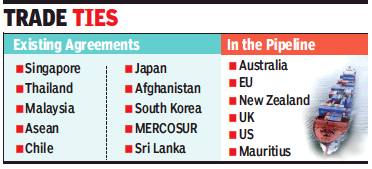Focus: GS-III Indian Economy
Why in news?
Discussions have begun at the highest level leading the deliberations on a revamped strategy on Free Trade Agreements (FTAs), coinciding the External Affair’s minister’s statement that FTAs haven’t helped India build capacity.
Details
- The government is recalibrating its strategy on entering into free trade agreements (FTAs) in a bid to ensure that the treaties provide economic and strategic benefits.
- Separately, the focus is on alliances with “peaceful” countries, especially those with which India does not have a significant trade deficit.
- The finance ministry also has concerns over loss of revenue due to the trade agreements.
What is the concern raised?
- Free trade agreements are useful for expanding the country’s trade basket.
- But most treaties signed by India have failed to help domestic industry and have resulted in higher imports in several product segments, as local players are often uncompetitive.
How will different countries be considered?
- There is expected to be greater thrust to FTAs with Australia and the European Union, with the UK and the US among countries with which India will engage more aggressively, while recognising that there is no need to rush into a deal.
- There is eagerness to rework the agreements with ASEAN and Japan, as imports are seen to have gained more than exports due to a sharp reduction in tariffs.
- India was expected to benefit more on the services front, with software professionals and nurses getting easy access to markets such as Japan, Singapore, South Korea and Malaysia.
- What has complicated matters is the presence of Chinese companies in ASEAN countries, which use the benefit of lower tariffs to route goods into India.

What is a Free Trade Agreement (FTA)?
- A free trade agreement is a pact between two or more nations to reduce barriers to imports and exports among them.
- Under a free trade policy, goods and services can be bought and sold across international borders with little or no government tariffs, quotas, subsidies, or prohibitions to inhibit their exchange.
- Free trade is the opposite of trade protectionism.
- FTA allows businesses in each country to focus on producing and selling the goods that best use their resources while other businesses import goods that are scarce or unavailable domestically.
- That mix of local production and foreign trade allows economies to experience faster growth while better meeting the needs of its consumers.
-Source: Times of India



